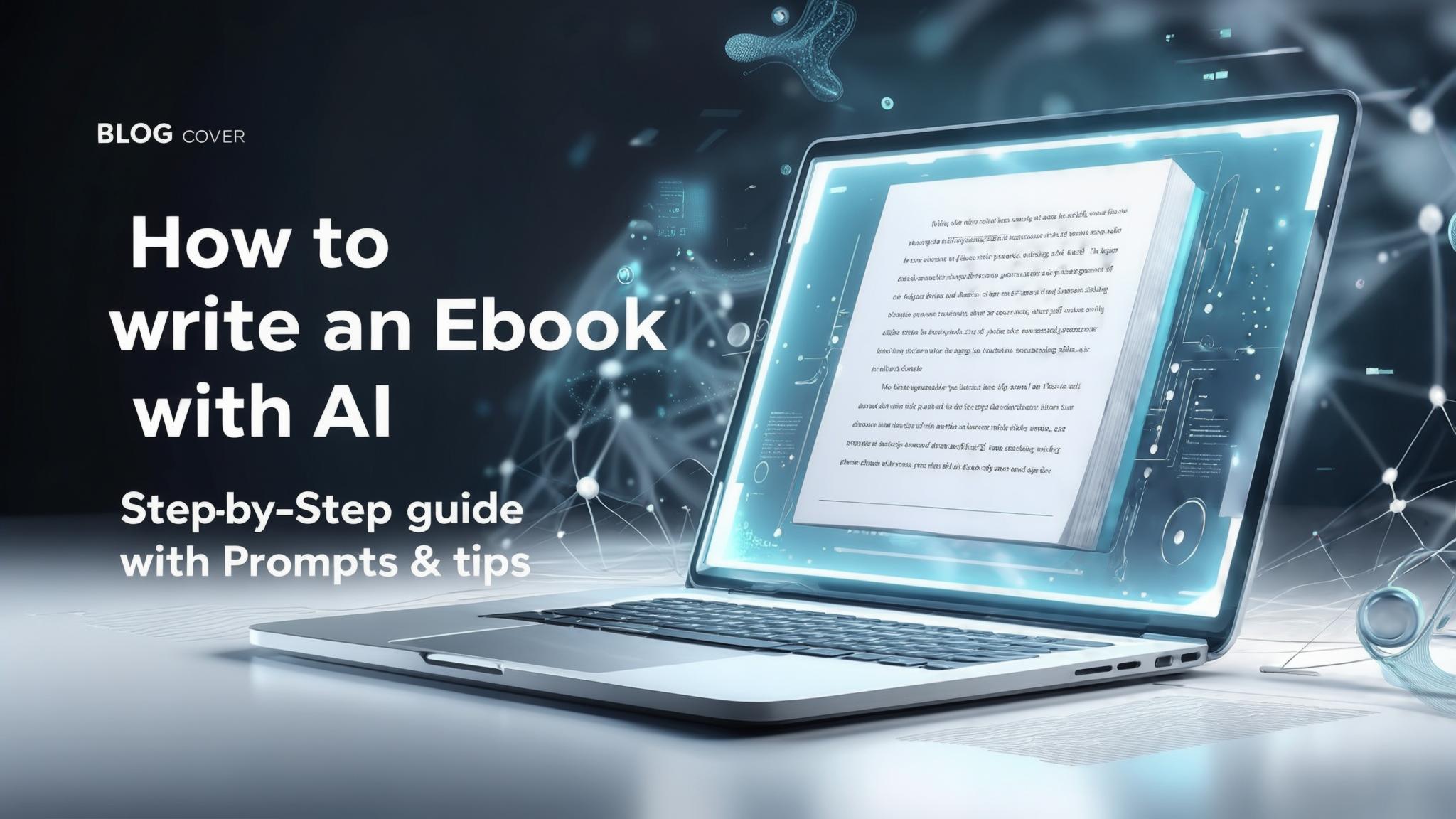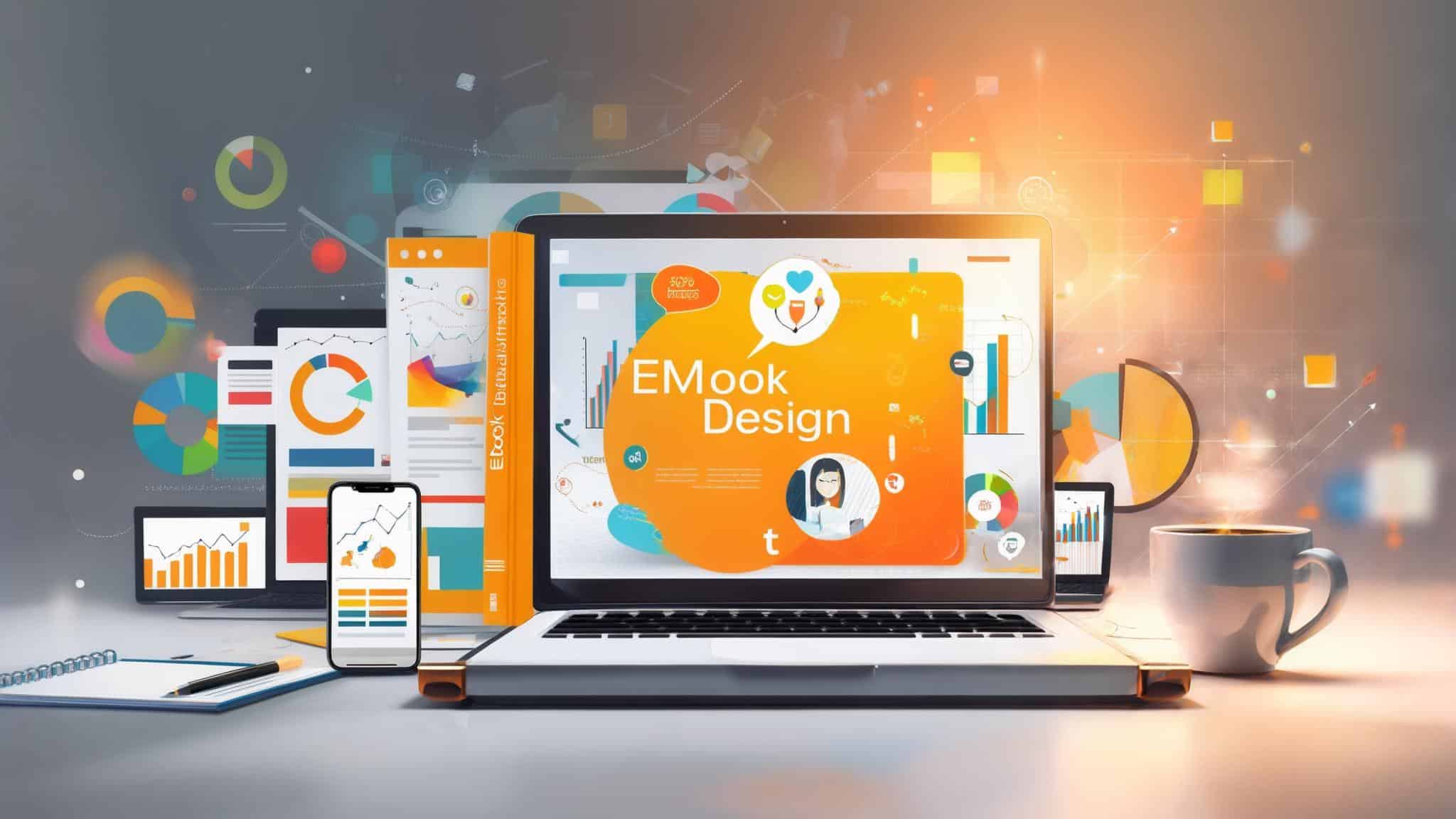
How to write an Ebook with AI: Step-by-Step guide with Prompts & tips
Stéphanie
March 06, 2025
🎯 Why use AI to write an eBook?
Writing an eBook can be a daunting task, requiring time, effort, and creativity. However, AI-powered writing tools can streamline the process, helping authors generate ideas, structure their content, and refine their writing. AI doesn’t replace human creativity—it enhances it, making the writing process more efficient and accessible. These tools assist with research, grammar correction, and style improvement, ensuring consistency and clarity. They also help overcome writer’s block by suggesting relevant topics, outlines, and even compelling phrasing. Whether you're an experienced author or a beginner, AI can be a powerful ally in crafting high-quality, engaging content while saving precious time.
📌 Benefits of AI-assisted writing
✅ Speed and Efficiency: AI can generate high-quality drafts in minutes.
✅ Idea Generation: AI helps brainstorm topics and structure your content.
✅ Consistency: AI ensures a uniform tone and style across the eBook.
✅ Editing Support: AI tools can refine, rewrite, and optimize content for readability.
✅ SEO Optimization: AI can suggest keywords to improve search visibility.
📘 Step 1: Define your Ebook’s purpose and audience
💡 Before you start writing, it’s essential to define why you’re creating this eBook and who it’s for. A clear purpose and well-defined audience will help shape your content, making it more relevant, engaging, and impactful.
📌 Best practices for defining your Ebook’s purpose and audience
✔️ Identify your target readers: Are you writing for beginners, professionals, entrepreneurs, or hobbyists? Understanding your audience helps tailor your tone and content.
✔️ Solve a specific problem: The best eBooks address a clear pain point or provide valuable insights that readers are actively looking for.
✔️ Define your unique value proposition: What makes your eBook different from others on the same topic? Consider your personal expertise, unique approach, or exclusive case studies.
✔️ Align with your business or brand goals: Whether you’re using the eBook for lead generation, brand authority, or passive income, having a clear objective ensures strategic alignment.
✔️ Validate your idea: Research your niche, analyze competitors, and see what’s trending to make sure there’s demand for your eBook’s topic.
✏️ AI Prompts for generating Ebook ideas
-
"Suggest 10 profitable Ebook topics in [industry/niche]."
-
"What are the trending topics in [field] that would make a great Ebook?"
-
"Give me a list of pain points my audience faces in [niche]."
-
"Generate a unique angle for an Ebook about [topic]."
-
"What are the most frequently asked questions about [subject]?"
-
"Suggest innovative sub-niches for an Ebook in [industry]."
-
"Create a compelling Ebook concept around [theme]."
-
"List common myths about [topic] and how an Ebook can debunk them."
-
"Give me 5 case study ideas to include in an Ebook about [topic]."
-
"Suggest a powerful hook for an Ebook introduction on [subject]."
📝 Step 2: Outline your Ebook structure
💡 A well-structured eBook enhances readability, engagement, and the overall flow of information. Before diving into writing, it's essential to create a clear outline that organizes your ideas logically. A solid structure ensures that your content is easy to follow and keeps readers interested from start to finish.
📌 Best practices for structuring your Ebook
✔️ Start with a strong title & subtitle: Your title should be clear, compelling, and reflect the book’s main topic or value.
✔️ Write an engaging introduction: Hook your readers by addressing their pain points, explaining what they’ll learn, and setting the tone for the rest of the book.
✔️ Organize your main chapters clearly: Arrange the content in a logical order, making it easy to follow and digest. Consider using numbered steps, thematic sections, or case studies.
✔️ Include a conclusion & call-to-action: Summarize key takeaways and guide readers on what to do next, whether it’s applying what they’ve learned, exploring additional resources, or purchasing another product.
✔️ Use consistent formatting: Headings, subheadings, bullet points, and visuals improve readability and make navigation easier.
✏️ AI Prompts for structuring an Ebook
-
"Create an outline for an Ebook about [topic]."
-
"Generate a table of contents for an Ebook on [subject]."
-
"What are the key sections I should include in an Ebook about [niche]?"
-
"Suggest a logical chapter flow for an educational Ebook on [theme]."
-
"How should I structure my Ebook to keep readers engaged?"
-
"What are the best ways to organize complex information in an Ebook?"
-
"Give me 3 different outline structures for an Ebook on [topic]."
-
"How can I create a compelling narrative flow in a non-fiction Ebook?"
-
"What are the essential elements of a strong introduction for an Ebook?"
-
"List 5 common mistakes in Ebook structuring and how to avoid them."
🤖 Step 3: Generating content with AI
💡 Once your outline is ready, you can start drafting your eBook using AI tools like ChatGPT, Jasper, or Writesonic. These tools can help you expand on ideas, structure your content, and maintain a consistent tone throughout your book.
📌 Best for AI-generated content
AI can be a powerful writing assistant, but to create high-quality content, follow these best practices:
✔️ Provide clear instructions: The more specific your prompt, the better the AI’s response will be. Define the tone, style, and key points you want to include.
✔️ Break it down: Generate content one section at a time to maintain coherence and avoid generic responses.
✔️ Mix AI with your expertise: AI can provide structure and ideas, but your personal knowledge and unique insights will make the Ebook truly valuable.
✔️ Ensure consistency: Use AI to generate content in a uniform voice and style, making adjustments where needed.
✔️ Edit and improve: AI-generated text may need revisions for readability, clarity, and engagement. Refer to Step 4: Refining and Editing for optimization tips.
✏️ AI Prompts for writing engaging content
-
"Write an engaging introduction for an Ebook about [topic]."
-
"Expand on this chapter outline: [insert chapter title]."
-
"Generate a compelling opening paragraph for a chapter on [subject]."
-
"Write a persuasive section explaining [concept]."
-
"Provide a step-by-step explanation of [process]."
-
"Create an inspiring conclusion for an Ebook about [niche]."
-
"Summarize this chapter while keeping it engaging: [paste text]."
-
"Rewrite this paragraph to improve clarity and impact: [paste text]."
-
"Suggest an anecdote or real-life example to illustrate [point]."
-
"How can I make this section more persuasive and engaging? [paste text]."
✍️ Step 4: Refining and editing your AI-generated content
💡 AI-generated content provides a strong starting point, but it often requires human refinement to improve clarity, coherence, and engagement. Editing ensures that your Ebook maintains a natural flow, aligns with your unique voice, and resonates with your audience.
📌 Best practices for editing AI-generated content
Editing AI-generated text involves multiple layers of refinement:
✔️ Improving readability: Break long paragraphs into digestible chunks and ensure smooth transitions.
✔️ Enhancing clarity: Remove redundant words, clarify ambiguous phrases, and simplify complex ideas.
✔️ Adjusting tone and style: Make sure the tone aligns with your target audience, whether it’s conversational, professional, or persuasive.
✔️ Fact-checking and consistency: Verify AI-generated facts and maintain consistency in terminology and formatting.
✔️ Grammar and syntax corrections: Ensure proper sentence structure, grammar, and punctuation for a polished final product.
To streamline the editing process, use AI tools like Grammarly, ProWritingAid, or Hemingway Editor to refine your text before conducting a manual review.
✏️ AI Prompts for editing and rewriting
-
"Rewrite this paragraph to make it more engaging: [paste text]."
-
"Summarize this chapter in a more concise way: [paste text]."
-
"Improve readability and flow in this section: [paste text]."
-
"Check grammar and style in this passage: [paste text]."
-
"Make this text sound more conversational: [paste text]."
-
"Rephrase this section for a more professional tone: [paste text]."
-
"Highlight and fix any passive voice issues in this content: [paste text]."
-
"Break this dense paragraph into shorter, clearer sentences: [paste text]."
-
"Suggest alternative phrasing for this sentence: [paste text]."
-
"Detect and correct any repetitive phrases in this chapter: [paste text]."
🎨 Step 5: Designing and formatting your Ebook
💡 The presentation of your Ebook is just as important as its content. A visually appealing and well-structured design enhances readability, engagement, and perceived value. Proper formatting ensures a seamless reading experience across different devices, from e-readers to tablets and smartphones.
📌 Choosing the right tools for design and formatting
There are several tools available to help you design and format your eBook professionally:
- Canva – Ideal for creating stunning Ebook covers with customizable templates.
- Adobe InDesign – A powerful tool for professional Ebook layout and typography.
- Microsoft Word – A beginner-friendly option with built-in formatting features.
- Reedsy – A free online tool for formatting Ebooks with a clean and professional look.
- Scrivener – A great choice for organizing and formatting longer manuscripts.
When formatting your Ebook, keep in mind:
✔️ Font selection: Choose easy-to-read fonts like Garamond, Georgia, or Open Sans.
✔️ Spacing & layout: Use consistent margins, paragraph spacing, and indentation.
✔️ Headings & subheadings: Organize content clearly to improve readability.
✔️ Images & graphics: Add visuals to illustrate key concepts and break up text.
✏️ AI Prompts for design and layout
-
"Suggest cover design ideas for an Ebook about [topic]."
-
"What are the best font and layout choices for an Ebook in [genre]?"
-
"Generate a color scheme that aligns with [brand or theme]."
-
"How can I make my Ebook visually appealing and easy to read?"
-
"What are the best platforms to design an Ebook cover?"
-
"How do I create an engaging and professional Ebook layout?"
-
"Suggest ways to enhance readability through typography and spacing."
-
"Generate ideas for section dividers and visual elements in an Ebook."
-
"What are the best practices for inserting images in an Ebook?"
-
"How can I optimize my Ebook design for both print and digital formats?"
🚀 Step 6: Finalizing and publishing your Ebook
💡 Before your Ebook hits the digital shelves, it's essential to ensure that everything is in place for a smooth launch. This step involves choosing the right publishing platform, finalizing the content, and preparing your book for the world to see.
📌 Choosing the right publishing platform
There are several platforms available for self-publishing Ebooks, each offering different benefits depending on your goals. Some popular options include:
- Amazon Kindle Direct Publishing (KDP): Offers extensive reach and is ideal for beginners looking for easy access to a global audience.
- Smashwords: A great option for authors looking to distribute their Ebook across multiple retailers and libraries.
- IngramSpark: Ideal if you’re looking to distribute both digital and physical versions of your book.
When selecting a platform, consider factors like royalties, distribution channels, and ease of use. Some platforms allow you to set your price, run promotions, and track sales, which can be helpful for marketing efforts.
✏️ AI Prompts for writing a compelling Ebook description
-
"Write a brief and compelling description for an Ebook about [topic], highlighting its unique value and benefits to the reader."
-
"Generate a short, attention-grabbing blurb for an Ebook targeting [specific audience], focusing on the problem the book solves."
-
"Create a persuasive Ebook description using a conversational tone that makes readers feel excited to learn more about [topic]."
-
"Draft a description that appeals to readers who are interested in [niche], explaining how this Ebook will change their approach to [relevant challenge or goal]."
-
"Write a captivating description for an Ebook that explains how to [solve a specific problem], using language that sparks the reader’s curiosity."
-
"Write a concise description for an Ebook on [topic], focusing on the author's expertise and the impact the book will have on the reader."
-
"Write an engaging description for an Ebook on [topic], capturing attention by mentioning key questions that readers have about the subject."
-
"Write a convincing Ebook description using a friendly tone, highlighting the unique experience the reader will have while reading it."
-
"Create an Ebook description featuring testimonials or customer reviews that emphasize the impact of the book."
- "Generate a concise and impactful description for an eBook on [issue], focusing on the transformation the reader can expect after reading the book."
📣 Step 7: Marketing and promoting your Ebook
💡 Once your Ebook is published, the next crucial step is to market it effectively to reach your target audience. Marketing is essential to ensuring your book gets noticed amidst the crowded digital landscape.
📌 Best strategies to promote your Ebook
There are various strategies to promote your Ebook, including:
- Social media marketing: Leverage platforms like Instagram, Twitter, and Facebook to share sneak peeks, testimonials, and book launch updates.
- Email marketing: Create an email list and send out personalized newsletters to potential readers, offering exclusive content or discounts to encourage purchases.
- Collaborations and guest posts: Partner with influencers or bloggers in your niche to promote your Ebook through guest posts, interviews, or joint promotions.
- Paid Ads: Use platforms like Facebook Ads or Amazon Ads to target specific readers who might be interested in your content.
- Offer limited-time discounts: To increase visibility, run temporary discounts or free promotions to generate buzz around your book.
🚀 You can also check out our blog post featuring the best prompts for Facebook Ads.
✏️ AI Prompts for creating social media & email campaigns
-
"Create a social media post announcing the launch of my Ebook on [topic], focusing on the main benefits and including a call-to-action."
-
"Write an email campaign for my Ebook release, targeting people who are interested in [niche], including a personal story or testimonial."
-
"Generate a Facebook ad copy for my Ebook about [topic], using persuasive language that appeals to [specific audience]."
-
"Craft a Twitter post that promotes my Ebook on [subject], with a catchy headline and a link to purchase."
- "Create a series of Instagram posts to promote my Ebook on [topic], including inspiring quotes, a catchy visual, and a call to action to encourage purchases."
- "Write a launch email for my Ebook, offering a limited-time promotion to the first [number] buyers, emphasizing the immediate benefits they will receive."
- "Write a captivating tweet to promote my Ebook on [topic], with an intriguing question and a call to action to encourage purchases."
- "Create a LinkedIn post announcing the launch of my Ebook, sharing a key excerpt from the book that sparks interest among professionals in my field."
- "Write a 3-day email sequence to promote my Ebook, each email focusing on a specific feature or unique benefit of my Ebook."
- "Create an email marketing campaign offering exclusive content or a free excerpt of the Ebook to encourage readers to subscribe to my newsletter."
🎁 Bonus: Advanced marketing strategies to boost your Ebook success
Once your eBook is ready, implementing advanced marketing strategies is crucial to maximizing its visibility, reaching your target audience, and ultimately boosting sales. A well-thought-out promotional plan can make the difference between an overlooked publication and a bestseller. To help you achieve a successful launch and sustained engagement, here are three powerful tactics that will enhance your book’s exposure, attract readers, and drive conversions.
🎯 1. Launching a pre-order campaign to build anticipation
A pre-order campaign generates excitement around your Ebook before its official release. By creating anticipation, you capture your audience’s attention and maximize first-day sales.
🚀 Steps to set up a successful pre-order campaign:
✔️ Choose a platform:
- Amazon Kindle Direct Publishing (KDP) allows pre-orders up to 12 months in advance.
- Gumroad, Payhip, and Selz are great alternatives for direct sales.
✔️ Offer exclusive bonuses:
- A bonus chapter or exclusive excerpt.
- Access to a private group where readers can engage with you.
- A special discount for early buyers.
✔️ Create a countdown timer:
- Use a countdown timer on your website and social media to reinforce urgency.
✔️ Engage your audience:
- Tease the content by sharing snippets and beta reader testimonials.
- Encourage pre-orders with a strong call to action: "Be the first to read my Ebook and get an exclusive bonus!"
🎙 2. Using webinars and online events for promotion
Webinars and online events are powerful tools for establishing authority and driving sales.
🎯 Why webinars work for Ebook promotion?
🚀 Direct audience interaction: Build trust by answering questions in real time.
🚀 Demonstrating value: Explain why your Ebook is a must-have.
🚀 Immediate sales opportunity: Offer an exclusive deal at the end of the webinar.
🔥 How to set up a successful webinar?
✔️ Choose the right platform:
- Zoom, Webex, or Google Meet for interactive sessions.
- YouTube Live or Facebook Live for a broader reach.
✔️ Structure your webinar effectively:
- Introduction: Introduce yourself and explain why you wrote the Ebook.
- Value-Driven content: Share actionable insights related to your topic.
- Tease the Ebook: Highlight how it goes deeper and solves a specific problem.
- Call to Action: Offer an exclusive bonus for those who purchase immediately.
✔️ Promote your webinar in advance:
- Create an event on LinkedIn and Facebook.
- Send email invitations with a registration link.
- Post regular reminders on social media.
📱 3. Leveraging TikTok and YouTube Shorts for maximum visibility
Short-form videos are an essential tool for product promotion—including your Ebook!
🎯 Why use TikTok & YouTube Shorts?
🚀 High engagement: Short videos capture attention and are favored by algorithms.
🚀 Massive organic reach: Expand your audience without paid ads.
🚀 Perfect for storytelling: Share anecdotes, snippets, or tips from your Ebook.
🎥 Content ideas for Short-Form Videos
💣 Behind-the-Scenes: Show the Ebook creation process.
💣 Mini-Tutorials: Share quick, actionable tips related to your topic.
💣 Testimonials & reviews: Highlight reader feedback.
💣 Engaging Call to Action: Example—"Want to learn more? My Ebook is available now!"
📌 Best practices for TikTok & YouTube Shorts
✔️ Use trendy sounds & hashtags: Increase visibility with popular music and relevant hashtags.
✔️ Keep it short & punchy: 15–30 seconds is enough to grab attention.
✔️ Add subtitles & hooks: Start with a compelling question or bold statement.
✔️ Post consistently: Ideally, 3–5 videos per week for maximum reach.
🚀 Final thoughts: Combine these strategies for maximum impact
A multi-channel approach is key to an effective promotion. Here’s how to structure your campaign:
📅 Week 1–2: Tease your Ebook on TikTok and YouTube Shorts.
📅 Week 3–4: Launch your pre-order campaign and engage your audience.
📅 Week 5: Host a webinar to drive sales before and after the launch.
With these advanced strategies, your Ebook won’t go unnoticed, and you’ll maximize its impact! 🚀📖
🚀 You can also check out our blog post featuring the best prompts for email marketing.






